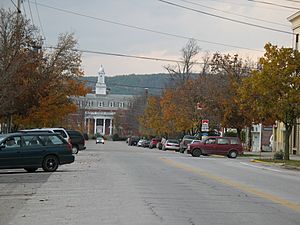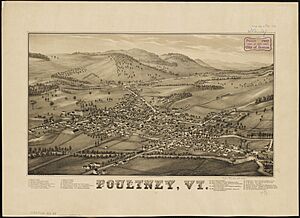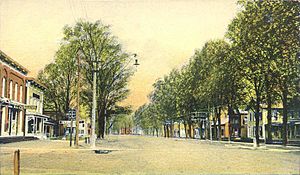Poultney (town), Vermont facts for kids
Quick facts for kids
Poultney, Vermont
|
|
|---|---|

Street in Poultney
|
|

Poultney, Vermont
|
|
| Country | United States |
| State | Vermont |
| County | Rutland |
| Chartered | 1761 |
| Communities |
|
| Area | |
| • Total | 44.8 sq mi (116 km2) |
| • Land | 43.9 sq mi (114 km2) |
| • Water | 0.9 sq mi (2.3 km2) |
| Population
(2020)
|
|
| • Total | 3,020 |
| • Density | 67.41/sq mi (26.03/km2) |
| Time zone | UTC-5 (Eastern (EST)) |
| • Summer (DST) | UTC-4 (EDT) |
| ZIP Codes |
05764 (Poultney)
05774 (Wells) |
| Area code(s) | 802 |
| FIPS code | 50-56875 |
| GNIS feature ID | 1462178 |
Poultney is a town in Rutland County, located in the southwestern part of Vermont. It shares its western border with New York and its northern border with Castleton, Vermont. Poultney was once home to Green Mountain College, a private college that closed in 2019. The smaller Village of Poultney is completely inside the town. In 2020, the town's population was 3,020 people.
Contents
Discovering Poultney's Past
Poultney was officially created on September 21, 1761. It was part of the "New Hampshire Grants," which were land claims made by the governor of New Hampshire. The town was named by Benning Wentworth, the Royal Governor of New Hampshire, after William Pulteney, 1st Earl of Bath, a British politician.
Early Settlers and First Families
The first people to settle in Poultney were Thomas Ashley and Ebenezer Allen. They built a cabin near the Poultney River on February 15, 1771. Ebenezer Allen brought his family, and his wife Lydia gave birth to a son in 1772. This was the first child born to white settlers in Poultney. Thomas Ashley planted corn and built a small shelter before bringing his own family later that year. Many of Ashley's brothers and other family members also moved to Poultney in the years that followed.
Growing Pains and the American Revolution
At first, Poultney grew slowly. This was because New York and New Hampshire were arguing over who owned the land in Vermont. By 1781, only 88 men were listed as official residents. Most of these early settlers came from Connecticut and Massachusetts.
Almost all the men in Poultney supported the American Revolution and fought in the war. In 1777, the British army, led by General John Burgoyne, threatened to invade Poultney. On July 8, 1777, the women and children had to leave the town for safety. Many families went back to their old homes in Massachusetts and Connecticut. After the British were defeated, the villagers returned to Poultney the next spring.
Ebenezer Allen left Poultney in 1783 to be the first settler in a new wilderness area in South Hero, Vermont. Thomas Ashley stayed in Poultney until he passed away in 1810. He was an important community leader, serving as a justice of the peace and representing Poultney in the Vermont General Assembly six times.
Historic Buildings and Famous Residents
A grist mill (a mill for grinding grain) was built in 1777, and the village of East Poultney grew up around it. East Poultney has many historic buildings. These include the Eagle Tavern, built around 1780, and the Baptist church, built in 1805 in the Federal style. The house where Horace Greeley lived in 1823 is also there.
East Poultney was once home to Heman Allen, who was Ebenezer Allen's brother and a cousin of the Revolutionary War hero Ethan Allen. Two very famous newspaper founders, Horace Greeley of the New York Tribune and George Jones of The New York Times, both lived in East Poultney in the late 1820s. Greeley worked as an apprentice at a local newspaper called the Northern Spectator from 1826 to 1830. The streets and green in East Poultney still look much like they did in the 1800s.
The Slate Industry and Welsh Immigrants
In the late 1800s, slate became a very important product from the Poultney area. Slate is a type of rock used for roofing, tiles, and building. This industry attracted many immigrants, especially from Wales. Many Welsh slate workers came to Poultney because they had experience with slate and faced hard times in their home country. It's said that many Welsh last names in the area are still pronounced the old Welsh way. The choir at Green Mountain College was even known for having the only fully Welsh music collection in the United States.
Today, both the East Poultney Historic District and the Poultney Village Historic District are listed on the National Register of Historic Places. Some of the old buildings there include the Union Academy (1791), the Melodeon Factory (1840), and the Victorian school house (1896).
Poultney also shares Lake St. Catherine, a large lake about 800 acres in size, with the nearby town of Wells.
Poultney's Geography
Poultney covers a total area of about 44.8 square miles. Most of this is land (43.9 square miles), and a small part is water (0.9 square miles). The town is located west of the Taconic Mountains. The Poultney River flows through the town and eventually empties into Lake Champlain.
Important roads that cross Poultney include Vermont Route 30, Vermont Route 31, and Vermont Route 140. The village of Poultney is located entirely within the town's borders.
Towns Near Poultney
 |
Hampton (NY) | Fair Haven | Castleton |  |
| Hampton (NY) | Ira | |||
| Granville (NY) | Wells | Middletown Springs |
Poultney's Population
| Historical population | |||
|---|---|---|---|
| Census | Pop. | %± | |
| 1790 | 1,121 | — | |
| 1800 | 1,694 | 51.1% | |
| 1810 | 1,905 | 12.5% | |
| 1820 | 1,955 | 2.6% | |
| 1830 | 1,909 | −2.4% | |
| 1840 | 1,880 | −1.5% | |
| 1850 | 2,329 | 23.9% | |
| 1860 | 2,278 | −2.2% | |
| 1870 | 2,836 | 24.5% | |
| 1880 | 2,717 | −4.2% | |
| 1890 | 3,031 | 11.6% | |
| 1900 | 3,108 | 2.5% | |
| 1910 | 3,644 | 17.2% | |
| 1920 | 2,868 | −21.3% | |
| 1930 | 3,215 | 12.1% | |
| 1940 | 2,781 | −13.5% | |
| 1950 | 2,936 | 5.6% | |
| 1960 | 3,009 | 2.5% | |
| 1970 | 3,217 | 6.9% | |
| 1980 | 3,196 | −0.7% | |
| 1990 | 3,498 | 9.4% | |
| 2000 | 3,633 | 3.9% | |
| 2010 | 3,432 | −5.5% | |
| 2020 | 3,020 | −12.0% | |
| U.S. Decennial Census | |||
In 2000, there were 3,633 people living in Poultney. The population density was about 82.7 people per square mile. Most residents (97.16%) were White. A small percentage were Black (0.69%), Native American (0.47%), or Asian (0.88%). About 0.58% of the population identified as Hispanic or Latino.
The median age in Poultney in 2000 was 36 years old. About 21.1% of the population was under 18, and 16.0% was 65 or older. The average income for a household was $31,711.
Famous People from Poultney
Many interesting people have connections to Poultney:
- Amsale Aberra, a fashion designer and business owner.
- Ebenezer Allen (1743–1806), a soldier and one of Poultney's first settlers.
- Heman Allen (1779–1852), a U.S. congressman.
- Jeffrey Brace (1742–1827), a Black Patriot soldier in the American Revolutionary War and an author.
- Oliver Cowdery (1806–1850), an important leader in the Latter Day Saint movement.
- William Duell, an actor and singer.
- Richie Grant, a soccer coach.
- Horace Greeley (1811–1872), a famous newspaper editor and politician.
- Oreola Williams Haskell (1875–1953), a women's suffrage activist, writer, and poet.
- David G. Hooker (1830–1888), a mayor of Milwaukee, Wisconsin.
- George Jones (1811–1891), who helped start The New York Times.
- Marcellus Jones (1830–1900), a soldier in the Civil War.
- William Miller (1782–1849), an American Baptist preacher.
- Edward H. Ripley, a businessman and Union Army officer in the Civil War.
- William Y. W. Ripley, a Union Army officer in the Civil War who received the Medal of Honor.
- George E. Royce, a businessman and banker.
- Ethan Smith (1762–1849), a clergyman and author.
- John E. Woodward (1870–1944), a U.S. Army brigadier general.
See also
 In Spanish: Poultney (Vermont) para niños
In Spanish: Poultney (Vermont) para niños




